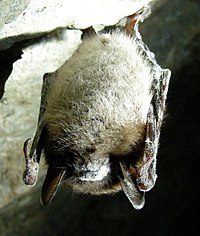
Photo from wikipedia
Abstract Understanding animals' behavioral and physiological responses to pathogenic diseases is critical for management and conservation. One such disease, white‐nose syndrome (WNS), has greatly affected bat populations throughout eastern North… Click to show full abstract
Abstract Understanding animals' behavioral and physiological responses to pathogenic diseases is critical for management and conservation. One such disease, white‐nose syndrome (WNS), has greatly affected bat populations throughout eastern North America leading to significant population declines in several species. Although tricolored bat (Perimyotis subflavus) populations have experienced significant declines, little research has been conducted on their responses to the disease, particularly in the southeastern United States. Our objective was to document changes in tricolored bat roost site use after the appearance of WNS in a hibernaculum in the southeastern U.S. and relate these to microsite temperatures, ambient conditions, and population trends. We censused a tricolored bat hibernaculum in northwestern South Carolina, USA, once each year between February 26 and March 2, 2014–2021, and recorded species, section of the tunnel, distance from the entrance, and wall temperature next to each bat. The number of tricolored bats in the hibernaculum dropped by 90.3% during the first 3 years after the arrival of WNS. However, numbers stabilized and slightly increased from 2018 to 2021. Prior to the arrival of WNS, 95.6% of tricolored bats roosted in the back portion of the tunnel that was the warmest. After the arrival of WNS, we observed a significant increase in the proportion of bats using the front, colder portions of the tunnel, particularly during the period of population stabilization and increase. Roost temperatures of bats were also positively associated with February external temperatures. Our results suggest that greater use of the colder sections of the tunnel by tricolored bats could have led to increased survival due to slower growth rates of the fungus that causes WNS in colder temperatures or decreased energetic costs associated with colder hibernation temperatures. Thus, management actions that provide cold hibernacula may be an option for long‐term management of hibernacula, particularly in southern regions.
Journal Title: Ecology and Evolution
Year Published: 2022
Link to full text (if available)
Share on Social Media: Sign Up to like & get
recommendations!